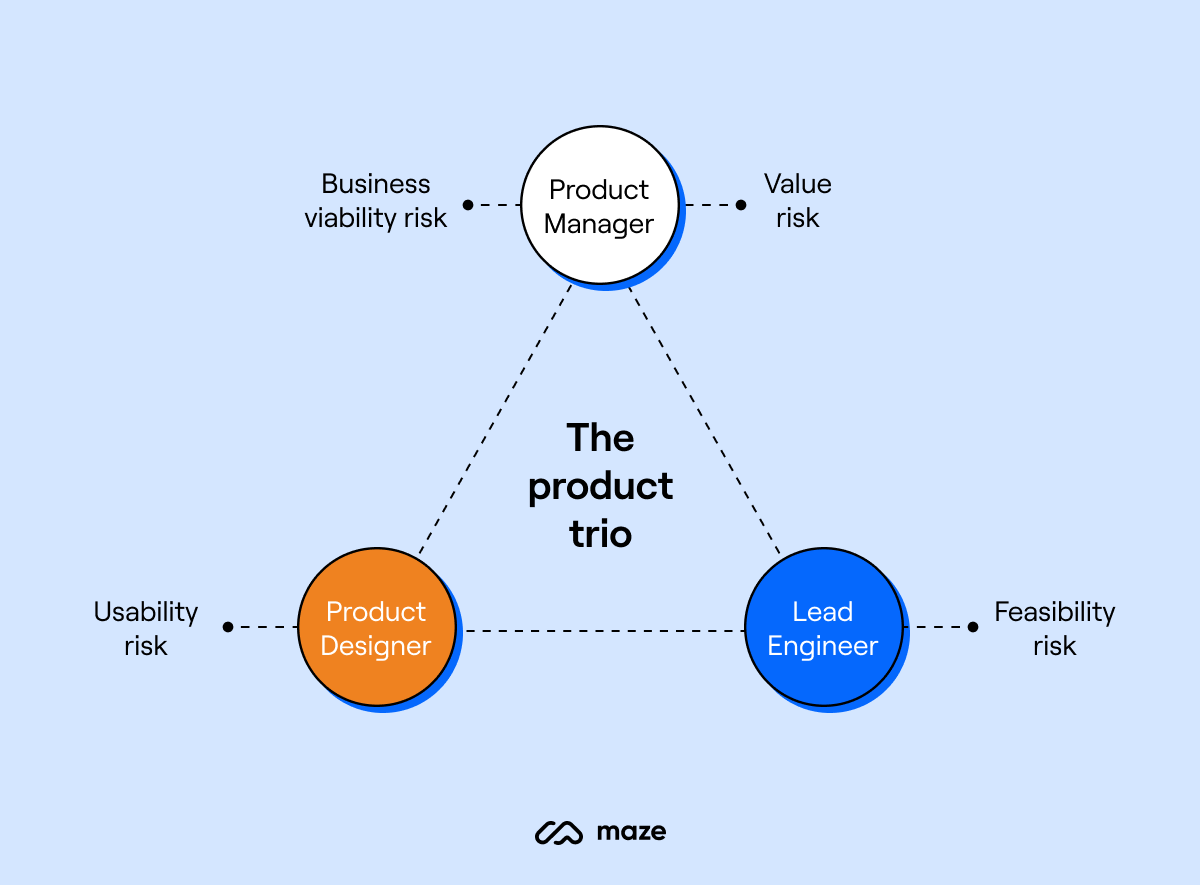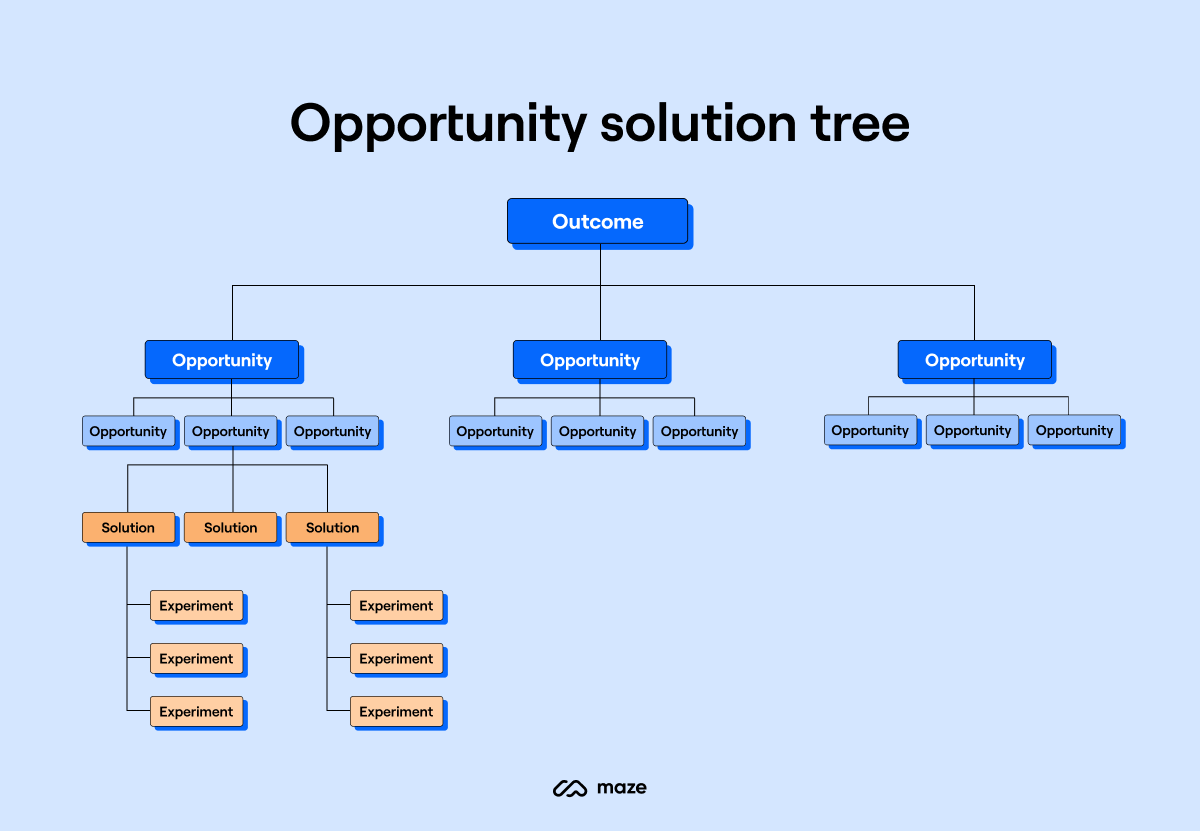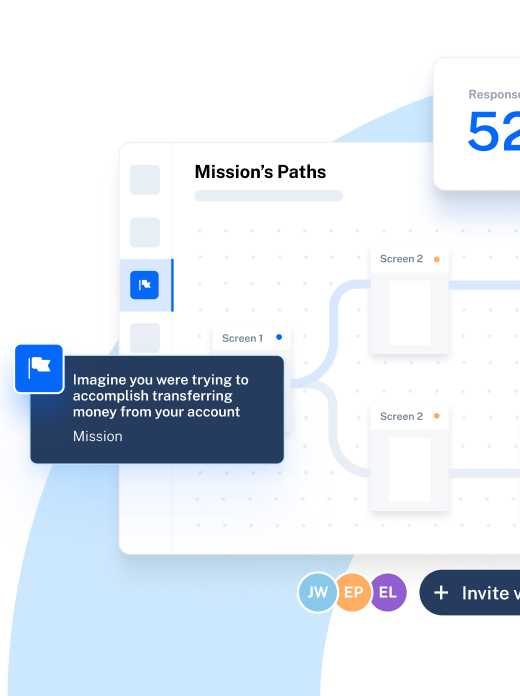Chapter 2
What is continuous product discovery? Everything you need to get started
Learn, synthesize, decide. Design, test, build. Next project, begin again.
In a project-based world, research is (maybe) conducted, decisions are made, then development begins. Product discovery hands off to product delivery.
But in a sprint-driven environment, time is tight for discovery. When you have to deliver quickly and often, teams struggle to do research throughout the product development cycle.
The solution: continuous product discovery.
According to author and coach Teresa Torres, Continuous product discovery includes “at a minimum, weekly touchpoints with customers by the team building the product, where they're conducting small research activities in pursuit of a desired product outcome.”
Weekly touchpoints with customers, at a minimum? Yes. While still turning out new product features and updates at a regular cadence? That's right. And this is also for small teams with fewer resources and smaller budgets? Absolutely.
And we’re going to show you why and how. But first, let’s unpack the ideas and methodology underlying continuous discovery.
What is continuous product discovery?
Continuous product discovery is a tool—and a mindset—that helps product teams decide what to build.
Let’s break down the definition, starting with the word product.
There was a time—which still exists in some companies today—when product decisions came from the ideas and intuitions of the product team, or worse—their executives. These ideas might come from:
- The startup CEO looking to scratch their own itch
- A PM whose gut tells them feature X will be a hit
- The loudest person in the workshop, brainstorm, or sprint planning
- An observation that a competitor just built a new feature
There can be value in these voices, but these inputs are missing an essential external perspective: the customer.
That’s why we add discovery.
Product discovery invites the user into the building process. It helps uncover what you should be building—and validating ideas for how you should build it—before jumping into development. It brings additional layers of insights through discovery techniques like:
- Customer interviews
- Product analytics
- Usability testing
- Rapid prototyping
- Surveys
- Content testing
Traditionally, product discovery is the first stage of the product development journey. Once you’ve gathered users’ needs, pains, and desires, you move on to the delivery stage, more confident that you’re building something that users actually want.
But a digital product is never finished. So discovery shouldn’t stop once you start delivering your validated product.
We need to make it continuous.
Continuous product discovery embraces the drive for customer feedback and makes it habitual. Learnings aren’t just gathered at the beginning of a project—they're collected through continuous communication with customers throughout the entire development lifecycle.

The continuous product discovery cycle 🔄
This approach has been popularized by internationally acclaimed coach and author of 'Continuous Discovery Habits', Teresa Torres. According to Teresa, you should be gathering insights from customers on at least a weekly basis.
These insights can be gathered through prototype tests, customer interviews, 5-second tests, contextual inquiries, surveys, and more. In fact, nearly any research method can be adapted to a continuous discovery process.
Tip ✨
To dive deeper into the principles and tactics of continuous product discovery, listen to our interview with Teresa Torres on the Optimal Path Podcast.
The bottom line: product teams aren’t spending enough time with their customers. And confident product decision-making requires a steady stream of insight from the people you’re building for.
Why is continuous product discovery important?
Successful product development is about co-creating with customers. And since a product is never really done, these customer conversations need to happen continuously.
Here are some other reasons why you need to make your discovery process continuous.
1. Evolve your product with your customer’s changing needs
There are always multiple ways to address a given challenge. And with every change to your product, a user may discover new needs and desires they hadn’t previously realized. Continuous discovery allows you to evolve your product alongside your users’ evolving needs.
Jonathan Widawski, Co-founder & CEO at Maze, puts it like this:
To win today and tomorrow, companies have to build the systems and processes to enable product organizations to deliver the right products, faster. That’s what continuous product discovery is about: it’s the belief that a product is a living, breathing thing and that users are central to shaping it.

Jonathan Widawski, Co-founder & CEO at Maze
2. Bring more clarity to backlog prioritization
No matter how much that last release boosted adoption or customer satisfaction, there’s always the next round of prioritization and refinement to decide what to build next.
Frequent customer conversations bring continuous clarity on how to best prioritize your product roadmap.
3. Increase confidence in your decisions
Even with a well-refined product discovery process, your studies and interviews will always be drawing from a limited sample. So there’s always the risk that research participants don’t reflect your target customer base.
Conducting frequent user research increases your sample size, boosts confidence that you’re discovering the most pressing and widely experienced user pains, and enables better decision-making—as long as you’re asking the right people the right questions, which we’ll get to below.
4. Align customer and business goals
Much of successful product design and development is about balancing the goals of your customers and those of the company. In an ideal world, the perfect solution for customers is the best driver of business value. But reality is often more nuanced.
Continuous interactions with users, alongside clear awareness of business goals, maximize the chances of finding that happy medium.
5. Avoid assumption-based development
No matter how objective we try to be, assumptions from product managers, UX designers, engineering teams, and sales squads are always lurking. And often these assumptions—built on small samples, confirmation bias, and personal desires—go undetected.
Continuous discovery opens the door for your customer to call out these assumptions.
How to get started with continuous product discovery
To effectively run continuous discovery—with a minimum weekly cadence—you have to set up systems to support it.
Here are six steps to help get you in the loop of continuous discovery.
1. Commit to a continuous mindset
Product discovery is not a linear phase that starts at project kick-off and ends with hand-off for delivery. Discovery and delivery are continuous processes that should happen in parallel. You’re always delivering, and you’re always discovering.
Arjen Harris, Director of Product at Maze, adds that discovery isn’t just about feeding delivery; it’s about challenging assumptions:
Continuous discovery goes beyond getting those few bullet points of data needed to back up a feature on the roadmap. It’s a mindset that’s always challenging the assumptions we think to be true, actively trying to poke holes and prove them wrong.

Arjen Harris, Director of Product at Maze
So establishing a continuous mindset is about transforming assumptions into hypotheses, using hypotheses to set up experiments, and using experiments to refine ideas.
As Teresa Torres puts it, the trick is to shift “from output-focus to outcome-focus.”
It’s not just about discovering what people need, then creating a solution (output-focus). It’s about keeping a particular goal in mind—be it customer satisfaction or monthly recurring revenue—and continually testing assumptions to help you reach those objectives (outcome-focus).
2. Assemble your discovery trio
If teams don’t start from the same set of assumptions and knowledge base, it’s hard to get them aligned on the same solutions.
To help overcome this, Teresa Torres suggests assembling a cross-functional team including a product manager, an experience designer, and a software engineer. A “product trio,” as she calls it.

The product trio
Their focus should be on collaboration, not on their specific roles.
This trio conducts continuous research together and creates a shared understanding of customer needs and opportunities to address their pains. They should be empowered to run their own interviews, without the need for a centralized research team.
3. Automate your weekly discovery process
Where will you ever find time to squeeze weekly research into an already busy schedule?
The simplest way is to block off a weekly recurring time for discovery. You can start with as little as 30 minutes. This way it’s built into the schedule, rather than a spontaneous appearance on your calendar.
And how do you recruit a steady stream of users?
One of the best solutions is allowing users to opt in while they’re using your product. It can be as simple as a pop-up asking “Do you have 20 minutes to talk about your product experience?” You’ll be surprised how many people are willing to share.
Another source is your Sales and Account teams. These folks are in constant communication with people who may be willing to participate in short usability studies.
Your goal is to reduce the need for your product team to be involved in the logistics. Ideally, they just show up during the weekly scheduled time, ready to ask the right questions.
4. Improve your research questions and techniques
As you increase the frequency of customer interactions, you also need to improve their effectiveness.
The first step is to ensure that you’re speaking to people familiar with the problem you’re aiming to solve. That’s why asking active customers is one of the best sources of feedback.
The next step is to make sure you’re asking the right questions. Here are a few tips for how to conduct better research.
- Be curious: Slow down and push deeper into your user’s experience.
- Avoid leading questions: Asking “What made this a good experience?” influences a participant’s response and skews your results. Instead, keep questions neutral like “How was your experience?”
- Listen first, ask second: We often worry so much about asking our next question that we don’t listen to the answers.
- Ixnay the jargon: Your language should be simple and straightforward. Remove internal lingo and industry-specific terms.
- Test your questions: Before an unmoderated study, run your questions by a few people to make sure they’re clear and easy to comprehend.
And remember to speak to humans. Nadine Krishnamurthy-Spencer, Product Manager at We Are With You, sums it up like this:
When it comes to running interviews, you have to be a bit more fluid than just reading from a script. If people don’t feel like it’s a genuine conversation, they’ll hold things back.

Nadine Krishnamurthy-Spencer, Product Manager at We Are With You
People are also prone to all kinds of cognitive biases and distortions. So another suggestion from Teresa Torres is to focus on past behavior, rather than ideal behavior. For example:
Instead of: ‘What do you like to eat?’
Try: 'Tell me about the last restaurant you went to.’
And remember: it’s not just about getting ideas, it’s about developing empathy for your users.
Need help with research questions?
Here’s a 350+ question bank of tried-and-true research and testing questions.
5. Visualize your thinking with opportunity trees and experience maps
A byproduct of continuous discovery is that you get inundated with information. From user needs, pains, and desires, to suggested solutions, features, and opportunities.
This is partly why you do it—to get ideas from actual and potential users, rather than being restricted to what you can come up with on your own.
Don’t try to hold it all in your head. Grab a whiteboard, a notebook, or a visual collaboration tool and visualize that information. Here are a few suggestions:
- Experience map: Draw out your understanding of your customers’ experiences and the surrounding opportunity space.
- Interview snapshot: Create a one-page summary from each interview you conduct.
- Opportunity solution tree: Start with a desired outcome at the root, then branch off into opportunities and potential solutions that come out of your customer interviews.
You can find out more about each of these in our interview with Teresa Torres.

The opportunity solution tree
6. Implement the right discovery tools
Opinions vary on what counts as a tool. For some, it’s about technology. For others, it starts with the five product discovery principles. Rather than diving into details, here are the main types of digital discovery tools to look into:
- Continuous discovery platform: Maze offers unified solutions for discovery, from prototype testing and surveys to other ways to collect actionable user insights (we admit we’re biased).
- Product analytics (quantitative): Amplitude, Mixpanel, and Google Analytics let you see what users are doing in your product.
- Product analytics (qualitative): To go beyond the numbers, tools like Hotjar and FullStory provide a deeper understanding of how users interact with your product.
- Feature flag management: Tools like LaunchDarkly let you easily test new features and gradually roll them out to users.
For a more complete look at tools recommended by real product managers, check out the last chapter of this guide for the best product discovery tools.
And if you’re ready to get started—or already fully engaged—with continuous product discovery, here’s a few final thoughts to help you on your way.
Tips for successful continuous product discovery
Ready to get started with continuous product discovery? Keep these tips in mind as you set off for more informed product perspectives.
- Start with a clear outcome, not a desired output. Don’t focus on the thing you’re aiming to build. Look at the impact of the solutions you’re delivering to your customers, and the added business value of your decisions.
- Commit to a continuous mindset, not discovery dogma. Don’t get caught in the feedback validation trap. Not all product decisions require lengthy, in-depth discovery. Sometimes it’s better to start building to get quicker feedback on a proposed solution.
- Do discovery to learn, not to confirm. Don’t approach research as a chance to validate your ideas. Think of discovery as an opportunity to test assumptions around what your users need, and how to best address their pains.
- Automate the discovery logistics, not the love. Don’t enter a testing session or interview with a rote set of questions to march through. But do put your weekly cadence on autopilot so that you can forget about scheduling. Then arrive at each discovery session with empathy, and let your care for your users’ needs guide the conversation.
- Embrace ‘in-progress’, not perfection. Don’t expect everything you deliver to be perfect. It never will be. A continuous mindset is okay with making things better with incremental value added. Your product is never finished.
- Think of discovery as a tool, not a phase. Don’t treat discovery as the thing you do at the start of each new project. Make it an ongoing source of feedback and assumption testing.
In the words of Netali Jakubovitz, our Group Product Manager at Maze:
The best discovery happens when it is thought of as a tool instead of a phase.

Netali Jakubovitz, Group Product Manager at Maze
That's a wrap on your intro to continuous product discovery, in the next chapter, let's take a look at five key product discovery principles.
Frequently asked questions about continuous product discovery
What does continuous product discovery mean?
What does continuous product discovery mean?
Traditional product discovery is the work teams do to decide what to build. Good discovery involves the voice of the customer, to make sure that product decisions are based on their needs and pains, not on the assumptions and desires of your Product teams.
Continuous product discovery turns traditional product discovery into a loop. It acknowledges that discovery activities don’t stop once product delivery begins. Instead, discovery continues throughout the entire product development process—discovery feeds delivery and delivery feeds discover, in a continuous loop.
How do you do continuous discovery?
How do you do continuous discovery?
Continuous product discovery requires an update in mindset and processes. Here��’s are the basic steps to get started:
- Commit to a continuous mindset focused on outcomes, not output
- Assemble your product trio: product manager + experience designer + engineer
- Automate your weekly discovery process
- Improve your research questions and techniques
- Visualize your thinking with opportunity trees and experience maps
- Implement the right discovery tools
What does good continuous product discovery look like?
What does good continuous product discovery look like?
When done right, continuous discovery relies on customer interactions on at least a weekly basis. It focuses on outcomes, not outputs. It tests assumptions, not ideas. Good discovery feeds a continuous stream of customer insights into your decision and prioritization frameworks. Ultimately, it leads to higher confidence that you’re building the right things for the right people.
